The role of potassium in inflammasome activation by bacteria
- PMID: 20097760
- PMCID: PMC2856258
- DOI: 10.1074/jbc.M109.067298
The role of potassium in inflammasome activation by bacteria
Abstract
Many Gram-negative bacteria possess a type III secretion system (TTSS( paragraph sign)) that can activate the NLRC4 inflammasome, process caspase-1 and lead to secretion of mature IL-1beta. This is dependent on the presence of intracellular flagellin. Previous reports have suggested that this activation is independent of extracellular K(+) and not accompanied by leakage of K(+) from the cell, in contrast to activation of the NLRP3 inflammasome. However, non-flagellated strains of Pseudomonas aeruginosa are able to activate NLRC4, suggesting that formation of a pore in the cell membrane by the TTSS apparatus may be sufficient for inflammasome activation. Thus, we set out to determine if extracellular K(+) influenced P. aeruginosa inflammasome activation. We found that raising extracellular K(+) prevented TTSS NLRC4 activation by the non-flagellated P. aeruginosa strain PA103DeltaUDeltaT at concentrations above 90 mm, higher than those reported to inhibit NLRP3 activation. Infection was accompanied by efflux of K(+) from a minority of cells as determined using the K(+)-sensitive fluorophore PBFI, but no formation of a leaky pore. We obtained exactly the same results following infection with Salmonella typhimurium, previously described as independent of extracellular K(+). The inhibitory effect of raised extracellular K(+) on NLRC4 activation thus reflects a requirement for a decrease in intracellular K(+) for this inflammasome component as well as that described for NLRP3.
Figures
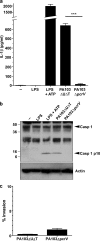
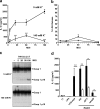
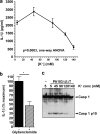
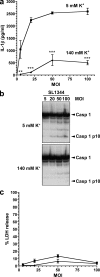
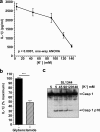


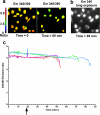

Similar articles
-
Bacterial Outer Membrane Vesicle-Mediated Cytosolic Delivery of Flagellin Triggers Host NLRC4 Canonical Inflammasome Signaling.Front Immunol. 2020 Nov 18;11:581165. doi: 10.3389/fimmu.2020.581165. eCollection 2020. Front Immunol. 2020. PMID: 33312172 Free PMC article.
-
Pseudomonas aeruginosa type-3 secretion system dampens host defense by exploiting the NLRC4-coupled inflammasome.Am J Respir Crit Care Med. 2014 Apr 1;189(7):799-811. doi: 10.1164/rccm.201307-1358OC. Am J Respir Crit Care Med. 2014. PMID: 24555512
-
Membrane vesicles from Pseudomonas aeruginosa activate the noncanonical inflammasome through caspase-5 in human monocytes.Immunol Cell Biol. 2018 Nov;96(10):1120-1130. doi: 10.1111/imcb.12190. Epub 2018 Aug 14. Immunol Cell Biol. 2018. PMID: 30003588
-
Inflammasome activation by Pseudomonas aeruginosa's ExlA pore-forming toxin is detrimental for the host.Cell Microbiol. 2020 Nov;22(11):e13251. doi: 10.1111/cmi.13251. Epub 2020 Sep 6. Cell Microbiol. 2020. PMID: 32779854
-
Redundant roles for inflammasome receptors NLRP3 and NLRC4 in host defense against Salmonella.J Exp Med. 2010 Aug 2;207(8):1745-55. doi: 10.1084/jem.20100257. Epub 2010 Jul 5. J Exp Med. 2010. PMID: 20603313 Free PMC article.
Cited by
-
α-Hemolysin of uropathogenic E. coli regulates NLRP3 inflammasome activation and mitochondrial dysfunction in THP-1 macrophages.Sci Rep. 2020 Jul 28;10(1):12653. doi: 10.1038/s41598-020-69501-1. Sci Rep. 2020. PMID: 32724079 Free PMC article.
-
Role of mitochondria ROS generation in ethanol-induced NLRP3 inflammasome activation and cell death in astroglial cells.Front Cell Neurosci. 2014 Aug 1;8:216. doi: 10.3389/fncel.2014.00216. eCollection 2014. Front Cell Neurosci. 2014. PMID: 25136295 Free PMC article.
-
Activation and regulation of the inflammasomes.Nat Rev Immunol. 2013 Jun;13(6):397-411. doi: 10.1038/nri3452. Nat Rev Immunol. 2013. PMID: 23702978 Free PMC article. Review.
-
Proton pump inhibitors protect mice from acute systemic inflammation and induce long-term cross-tolerance.Cell Death Dis. 2016 Jul 21;7(7):e2304. doi: 10.1038/cddis.2016.218. Cell Death Dis. 2016. PMID: 27441656 Free PMC article.
-
Activation of the pyrin inflammasome by intracellular Burkholderia cenocepacia.J Immunol. 2012 Apr 1;188(7):3469-77. doi: 10.4049/jimmunol.1102272. Epub 2012 Feb 24. J Immunol. 2012. PMID: 22368275 Free PMC article.
References
Publication types
MeSH terms
Substances
Grants and funding
LinkOut - more resources
Full Text Sources
Medical

